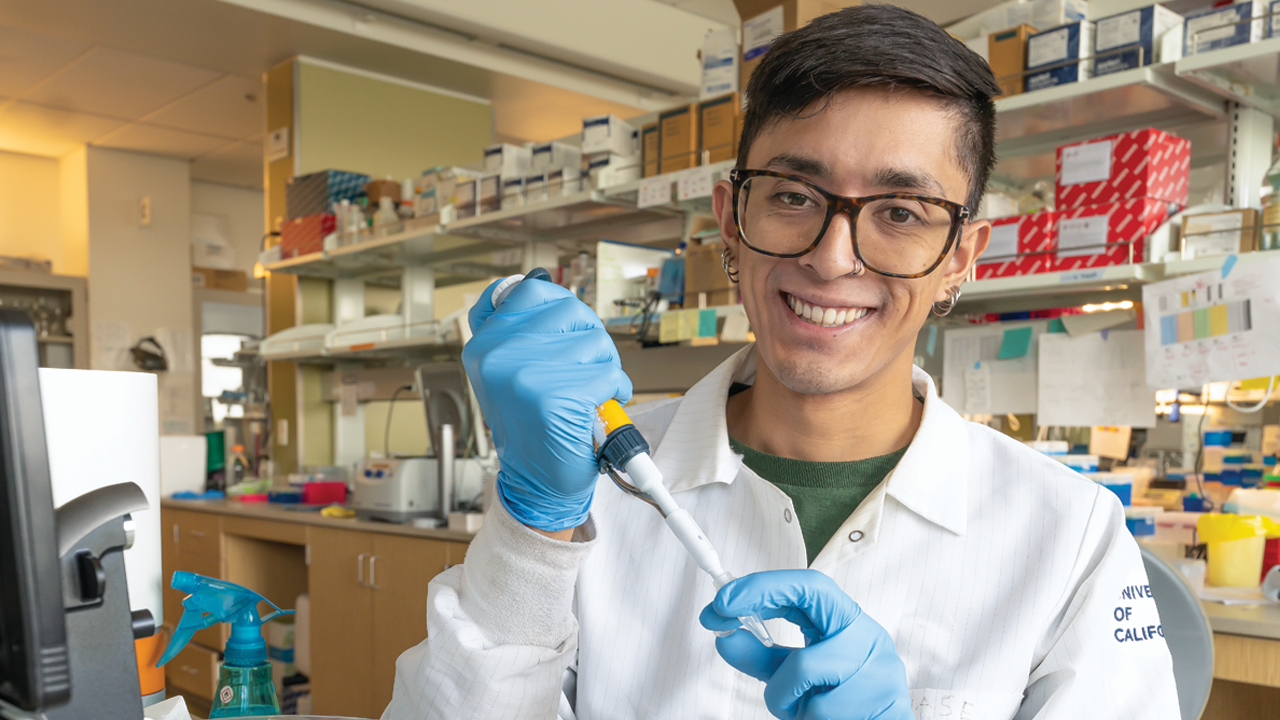
Leader in the Making
Chase Alejandro Garcia, Class of 2026

hase Alejandro Garcia, a dual degree DVM/Ph.D. student in the Veterinary Scientist Training Program (VSTP), is forging a career path that incorporates his love of animals and his interest in metabolic disease research, specifically related to Alzheimer’s disease. A native Californian, he grew up in San Diego and completed a degree in Metabolic Biology at UC Berkeley before coming to UC Davis.
Garcia’s interest in animals stems from a passion passed down from his grandmother and mother. His grandmother gifted him his first pet, a hamster named Sierra, when he was five. Then came a five-gallon guppy tank that evolved into a 20-gallon tank because, as Garcia puts it, “guppies are the rabbits of the fish world.” He quickly learned that there are “other fish at the fish store,” igniting a lifelong interest in fishkeeping. He now has two 120-gallon planted freshwater tanks at his home in Davis.

A vertebrate zoology course at Berkeley that included field trips to identify local birds, mammals, and reptiles helped cement Garcia’s interest in exotics, and introduced him to wildlife photography. He later completed a summer internship with a veterinary specialist in reptile and exotics medicine in San Diego where he was exposed to a variety of species—from large tortoises to green iguanas. He brought the skills he learned to Davis where he now takes in reptiles that need homes.
I call my house ‘Chase’s Home for Unwanted Reptiles’.”
“I call my house ‘Chase’s Home for Unwanted Reptiles’,” joked Garcia. His reptilian roommates include geckos and a ball python. Although his first passion was veterinary medicine, Garcia chose the dual degree program because he knew he wanted to pursue a career beyond general practice. He originally planned his undergraduate courses with the goal of attending veterinary school. Halfway through his time at Berkeley, he became interested in medical research. His participation in the VSTP now allows him to explore both paths.
The goal of the VSTP is to produce highly qualified veterinary-scientists as future leaders in academic medicine, biomedical research, and government service.
The goal of the VSTP is to produce highly qualified veterinary-scientists as future leaders in academic medicine, biomedical research, and government service. After completing his first two years of veterinary school, Garcia is now nearing the completion of his Ph.D., planned for this summer. He will then return to veterinary school for his final two years.
Garcia is a graduate student in Dr. Gino Cortopassi’s laboratory where he studies metabolic components of Alzheimer’s disease. Although Alzheimer’s is not traditionally considered a metabolic disease, Garcia approaches it from a different angle, applying his strong background in metabolic biology to examine therapeutic ketosis for functional longevity and treatment of the disease.
When he is not in the laboratory or the classroom, Garcia spends much of his time outdoors. He loves to camp, backpack, and travel, looking for landscape and wildlife photography subjects.
If you are interested [in a dual degree], go for it ... Just remember that it is a marathon, not a sprint.”
As the first person in his family to pursue a doctorate, Garcia is driven to succeed, but also works hard to maintain perspective. He knows that the dual degree program is the right path for him, and encourages others considering this route to approach it with the right expectations.
“If you are interested, go for it, because it opens a lot of doors for you no matter what you do in the end,” said Garcia. “Just remember that it is a marathon, not a sprint.”
